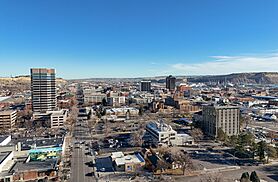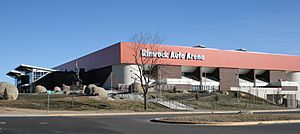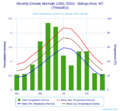Billings, Montana facts for kids
Quick facts for kids
Billings
|
|||||
|---|---|---|---|---|---|
|
City
|
|||||
|
Four Dances Natural Area
First Interstate Center
Billings Logan International Airport
Yellowstone County Courthouse
|
|||||
|
|||||
| Nickname(s):
"Magic City", "City by the Rims", "Star of the Big Sky Country", "Montana's Trailhead"
|
|||||

Location within Yellowstone County
|
|||||
| Country | United States | ||||
| State | Montana | ||||
| County | Yellowstone | ||||
| Founded | 1877 | ||||
| Incorporated | March 24, 1882 | ||||
| Named for | Frederick H. Billings | ||||
| Government | |||||
| • Type | Mayor-Council | ||||
| Area | |||||
| • City | 45.39 sq mi (117.57 km2) | ||||
| • Land | 45.29 sq mi (117.29 km2) | ||||
| • Water | 0.11 sq mi (0.28 km2) | ||||
| Elevation | 3,212 ft (979 m) | ||||
| Population
(2020)
|
|||||
| • City | 117,116 | ||||
| • Rank | US: 242nd MT: 1st |
||||
| • Density | 2,586.08/sq mi (998.50/km2) | ||||
| • Urban | 114,773 (US: 273rd) | ||||
| • Metro | 187,037 (US: 232nd) | ||||
| Time zone | UTC−7 (Mountain) | ||||
| • Summer (DST) | UTC−6 (Mountain) | ||||
| ZIP codes |
59101-59117
|
||||
| Area code(s) | 406 | ||||
| FIPS code | 30-06550 | ||||
| GNIS feature ID | 2409849 | ||||
| Highways | |||||
Billings is the largest city in Montana, a state in the western United States. About 117,000 people lived here in 2020. Billings is in the south-central part of Montana. It is the main city of the Billings Metropolitan Area, which has over 187,000 people.
Billings is a very important center for trade and distribution. It serves a huge area, covering more than 125,000 square miles. This means it's a major shopping spot for many people in Montana and nearby states.
The city is often called the "Magic City." This nickname came about because it grew so quickly. It started as a railroad town in March 1882. The Crow and Cheyenne tribes called the city Ammalapáshkuua and É'êxováhtóva. These names mean 'where they cut wood,' because of an early sawmill. Billings has continued to grow fast and has a strong economy.
Many cool places to visit are in and around Billings. These include ZooMontana, the Yellowstone Art Museum, and Pompey's Pillar. You can also see Pictograph Cave and Little Bighorn Battlefield. Yellowstone National Park is also not too far away.
Contents
History of Billings
How Billings Got Its Name
The city is named after Frederick H. Billings. He used to be the president of the Northern Pacific Railroad. Before it was Billings, the area was known as Clark's Fork Bottom.
The Crow people call the city Ammalapáshkuua. This means 'where they cut wood'. The Cheyenne people called it É'êxováhtóva, which also means 'sawing place'. Both names refer to a sawmill built by early settlers.
Ancient Times
Millions of years ago, the Billings area was covered by a sea. This sea left behind layers of sand. Over time, this sand turned into stone. The Yellowstone River then carved its way through this stone. This created the tall canyon walls called the Billings Rimrocks, or "the Rims."
The Pictograph Caves are just south of downtown. These caves have over 100 rock paintings. The oldest paintings are more than 2,000 years old. Scientists have found about 30,000 old tools and weapons there. This shows people lived in the area for a very long time.
The Crow Indians have lived in the Billings area since about the 1700s. Their reservation is still just south of the city today.
Lewis and Clark's Visit
In July 1806, William Clark from the Lewis and Clark Expedition explored the Billings area. On July 25, he reached a famous rock now called Pompey's Pillar. He wrote in his journal that he climbed the rock and saw a huge view. Clark carved his name and the date into the rock. This is the only physical proof left of their journey.
From Coulson to Billings
Before Billings, there was a town called Coulson. It was started in 1877 by settlers. Coulson was a busy place for moving goods by riverboats. It was a rough town with many saloons. Liver-Eating Johnson, a famous mountain man, was even the sheriff there.
Coulson had a graveyard called Boothill Cemetery. It was called Boothill because many people buried there were said to have "died with their boots on." Today, Boothill Cemetery is the only part of old Coulson that still exists.
When the railroad came, it decided to build a new town, Billings, a couple of miles away. Most people from Coulson moved to the new, growing town. Coulson slowly disappeared, and today, Coulson Park sits where the old town once stood.
The "Magic City" Grows
Billings was officially founded in 1882. It was named after the railroad president, Frederick H. Billings. The railroad wanted a new hub for its expansion. At first, Billings had only three buildings. But in just a few months, it grew to over 2,000 people. This quick growth is why it was nicknamed the "Magic City."
Billings in the 1900s
By 1910, Billings had over 10,000 people. It was one of the fastest-growing cities in the country. Billings became important for energy because of oil, natural gas, and coal found nearby. It became a major trading and energy center for eastern Montana and northern Wyoming.
After World War II, Billings grew into a big center for finance, medicine, and culture. The city's population grew very fast for many years. In the 1970s and 1980s, many tall buildings were built downtown. The First Interstate Center became the tallest building in Montana.
Billings also became a popular shopping spot. New shopping centers and malls were built. In 1992, Billings won the All-America City Award for its community efforts.
Billings Today
In the 2000s, big companies like GE and Wells Fargo opened offices in Billings. The downtown area was improved, and many historic buildings were restored. In 2007, Billings was named a Preserve America Community.
The city has also worked to be more eco-friendly. Its bus center was the first in the U.S. to get a special "LEED Platinum" award for being green. In 2022, Billings became the first city in Montana to get "LEED Gold" certification.
New roads and bridges have been built to help the city grow. In 2010, a tornado hit parts of Billings. It caused damage to buildings like the MetraPark Arena. In the 2010s, Billings also benefited from a big oil discovery nearby, which helped the economy.
Geography and Nature
Billings is split by long cliffs called the Rims. These cliffs are about 500 feet tall to the north and 800 feet tall to the east of downtown. The Yellowstone River flows through the southeast part of the city. Billings is about 3,126 feet above sea level.
Nearby Mountains
Around Billings, you can see seven different mountain ranges. The Bighorn Mountains have over 200 lakes and very tall peaks. The Pryor Mountains are home to the Pryor Mountain Wild Horse Range, where wild horses roam free.
The Beartooth Mountains have Granite Peak, which is the highest point in Montana. The Beartooth Highway through these mountains is known as one of the most beautiful drives in America. Other ranges include the Crazy Mountains, Big Snowy Mountains, Bull Mountains, and Absaroka Range.
Weather in Billings
Billings has warm, dry summers and cold, dry winters. Temperatures can sometimes reach over 100°F in summer. In winter, it can drop below 0°F. Billings gets about 57 inches of snow each year. However, warm chinook winds often melt the snow quickly.
Spring and autumn are usually mild. Winds can be strong but are generally lighter than in other parts of Montana. Billings can also have severe summer storms, like the tornado in 2010.
Parts of the City
Billings has many different areas, often shaped by its unique landscape. The "Rims," a 500-foot cliff, separates areas like the Heights from downtown.
There are 11 main sections within Billings. The south side is one of the oldest parts of the city and has many different cultures. The West End is growing fast with new shops and homes. Downtown has a mix of small businesses, restaurants, and a fun brewery district. The Heights is mostly homes, and new schools have been built there due to growth.
Tallest Buildings
The tallest building in Billings, and all of Montana, is the First Interstate Center. It is 272 feet tall and has 20 floors. Billings is also home to the DoubleTree Tower. This building is 256 feet tall and has 22 floors. It was once the tallest load-bearing brick building in the world.
Surrounding Areas
Billings is the main city of the Billings Metropolitan Area. This area includes three counties: Yellowstone, Stillwater, and Carbon. The total population of this area was about 184,000 people in 2020.
People of Billings
Billings is the most populated city in Montana. In 2020, about 117,116 people lived here. The city has grown steadily over the years.
Most people in Billings are White. There are also significant populations of Native American and Hispanic or Latino people. The city is becoming more diverse.
The average income for families in Billings has grown. In 2021, the average household income was about $63,608.
What Billings is Known For
Billings' location has always been key to its success. It started as a railroad hub and quickly became a major trade and distribution center. Billings serves over half a million people in its trade area. Since Montana has no sales tax, many people from Wyoming and the Dakotas come to Billings to shop.
Billings is also an important energy center. It is surrounded by large coal, oil, and natural gas fields. Three of Montana's four oil refineries are in Yellowstone County, where Billings is located.
In 2009, Fortune Small Business magazine called Billings the best small city to start a business. The city has a strong and varied economy. This includes a growing medical field, retail, hotels, and entertainment. Other important industries are construction, banking, trucking, and agriculture.
Billings is a big farming area. The Western Sugar Cooperative Plant processes millions of dollars worth of sugar beets each year. Other crops like wheat and corn are also grown. Billings also has livestock auctions and many farm supply stores.
Fun Things to Do
Museums and History
- Moss Mansion Historic House Museum: A beautiful old house you can tour.
- Western Heritage Center: Learn about the history of the Yellowstone River Valley.
- Wise Wonders Children's Museum: A fun, hands-on museum for kids.
- Yellowstone Art Museum: See amazing art from the region.
- Yellowstone County Museum: Discover the history of Yellowstone County.
You can also visit historic spots like the Billings Depot, the Downtown Historic District, and Boothill Cemetery.
Zoos
- ZooMontana: A 70-acre zoo and botanical garden. It's home to animals from different parts of the world.
Entertainment Venues
- MetraPark: This is the largest indoor venue in Montana. It seats 12,000 people and hosts concerts, rodeos, and sports events.
- Alberta Bair Theater: A beautiful performing arts theater that opened in 1931. It hosts many shows and performances.
- Eagle Seeker Community Center: A smaller venue for concerts and events.
- Dehler Park: A stadium that is home to the Billings Mustangs baseball team.
- Wendy's Field at Daylis Stadium: Used for high school sports games.
- Centennial Ice Arena: A place for ice skating and hockey.
- Babcock Theater: A historic theater built in 1907. It shows movies and hosts events.
- Alterowitz Arena: Used for college sports and local events. It has a pool too!
- Fortin Center: An arena on the Rocky Mountain College campus for sports.
Arts and Events
Billings has a lively arts scene. You can find the Billings Public Library, Billings Studio Theater, and the Billings Symphony Orchestra. There are also groups like the Yellowstone Chamber Players.
Fun events in Billings include:
- Billings Pride Week (June)
- Strawberry Festival (July)
- MontanaFair (August): A big fair with rides, food, and shows.
- Billings Artwalk: Held every other month, where downtown businesses show local art.
Billings is also known for its many microbreweries and distilleries. You can follow the Billings Brew Trail to visit them.
Sports Teams
- Billings Mustangs: A baseball team that plays in the Pioneer League.
- Billings Outlaws: An indoor football team.
- The NILE Rodeo: A big rodeo event held at First Interstate Arena.
- Great American Championship Motorcycle Hill Climb: A famous motorcycle race up a hill.
Parks and Outdoor Fun
- Lake Elmo State Park: A great place for outdoor activities.
- Rimrocks ("The Rims"): The cliffs offer trails and amazing views.
- Skypoint: An artistic structure downtown where events are held.
- Yellowstone Kelly Interpretive Site: Learn about a famous frontiersman.
- Zimmerman Park: A park with trails and views.
Learning in Billings
Schools
Billings has many public schools. There are 22 elementary schools, six middle schools, and three high schools. These high schools are Senior High, Skyview High, and West High. About 15,715 students attend these schools.
There are also several private schools in Billings. These include Billings Catholic Schools, Trinity Lutheran School, and Billings Christian Schools.
Colleges and Universities
Billings has three colleges and universities:
- Montana State University Billings (MSU Billings): This is a public university. It offers many different degrees. About 4,000 students go here.
- Rocky Mountain College (RMC): This is Montana's oldest college, founded in 1878. It offers many majors and has about 1,000 students.
- Rocky Vista University: This is a private medical school that opened in 2023. It plans to open a veterinary medicine college too.
Getting Around Billings
Airports
Billings Logan International Airport is very close to downtown. It sits on top of the Rims, overlooking the city. You can catch passenger flights and cargo planes here.
The Laurel Municipal Airport is also nearby. It is used for private planes and helicopters.
Buses and Trails
The Billings METropolitan Transit (MET Transit) is the city's bus system. It has routes all over the city. All MET buses are wheelchair-friendly and have bike racks. There are transit centers downtown and on the West End to help you connect to different routes.
Billings also has a large and growing trail system. These trails are great for walking, running, and biking.
Highways and Roads
Interstate 90 runs through the southern part of Billings. It connects different areas of the city. Interstate 94 also connects to I-90.
U.S. Highway 87 goes through Billings Heights and is a very busy road. There are plans to improve many of the roads and bridges in and around Billings. A new project called the Billings Bypass will create a new bridge over the Yellowstone River and connect different parts of the city.
Trains
Currently, there are no passenger train services in Billings. However, there are plans to bring back the North Coast Hiawatha train route. This route used to connect Chicago to Seattle.
Healthcare in Billings
Billings has a large and growing healthcare industry. It employs many people in the city. Billings has two major hospitals that are Level I Trauma Centers. This means they can handle the most serious injuries.
- St. Vincent Regional Hospital: Founded in 1898, it is the second-largest hospital in Montana.
- Billings Clinic: Started in 1911, it is one of the largest employers in Montana. It was the first Level I Trauma Center in Montana and Wyoming.
There are also many other medical facilities in Billings, including clinics, treatment centers, and research centers.
Famous People from Billings
Many interesting people have lived in Billings, including:
Historical Figures
- Frank Borman: An astronaut.
- Will James: A famous artist and author.
- Calamity Jane: A well-known frontierswoman.
- Liver-Eating Johnson: A mountain man and sheriff.
- Charles Lindbergh: A famous aviator.
Sports Stars
- Mike Burton: An Olympic gold medalist in swimming.
- Dave McNally: A Major League Baseball pitcher.
- Andy Moog: A former NHL hockey player.
- Brent Musburger: A famous sportscaster.
Arts and Entertainment
- Stanley Anderson: An actor.
- John Dahl: A movie director.
- Arlo Guthrie: A folk singer.
- Bud Luckey: A famous animator for Pixar movies like Toy Story.
- Ralph McQuarrie: An Academy Award-winning designer for Star Wars.
- David Yost: An actor, known as the Blue Power Ranger.
Sister Cities
Billings has two sister cities:
 Billings, Hessen, Germany
Billings, Hessen, Germany Kumamoto, Kumamoto, Japan
Kumamoto, Kumamoto, Japan
Images for kids
See also
 In Spanish: Billings (Montana) para niños
In Spanish: Billings (Montana) para niños








































